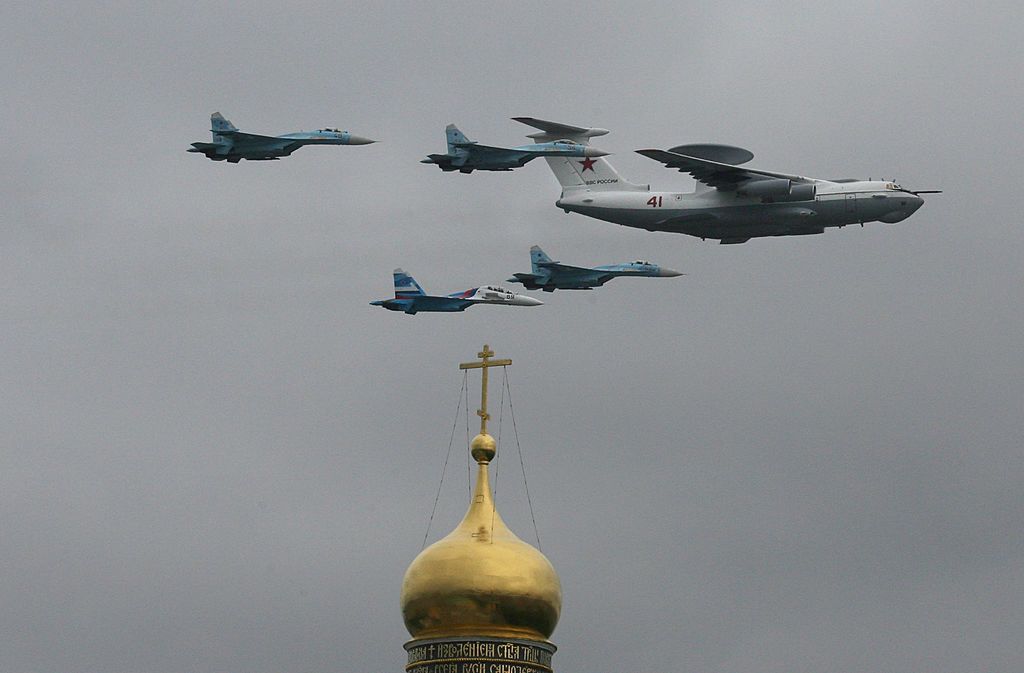Ukraine's air defense notches a string of successes against Russian air power

Ukraine has destroyed at least seven Russian planes since the beginning of December, a landmark military achievement for the country and a significant blow to Russia. The sharp uptick in downing planes in recent weeks emerges as a bright spot for Ukraine amid a lack of progress on the battlefield.
Commander-in-Chief Valerii Zaluzhnyi confirmed on Jan. 15 that Ukraine had destroyed a Russian Beriev A-50 military observation plane and an Ilyushin Il-22 plane that operates as an airborne command post. The downing came less than a month after Ukraine shot down four Russian planes within one week — three Russian Su-34 supersonic fighter-bomber aircraft and one Su-34 fighter-bomber jet near occupied Mariupol in Donetsk Oblast.
The A-50 alone reportedly costs $330 million, and although estimates vary, Western sources say that Russia has fewer than 10 in its fleet. The head of Ukraine's military intelligence agency (HUR), Kyrylo Budanov, told FT on Jan. 15 that Russia only has eight A-50 planes. Belarusian partisans attacked another A-50 aircraft at an airbase near Minsk in February 2023, causing an unknown amount of damage.
Russia's supply of the Il-22 plane is not extensive either. During the short-lived rebellion of the late Yevgeny Prigozhin's Wagner mercenary group in June 2023, the mutineers reportedly shot down an Il-22 and six Russian military helicopters. At the time, the U.K. Defense Ministry said that Russia only had 12 such aircraft.
Beyond Ukraine's downing of the planes, another Su-34 jet was allegedly burned down on Jan. 4 at the Shagol airbase outside of the Russian city of Chelyabinsk, some 2,000 kilometers east of the Ukrainian border.
Earlier on Jan. 4, Ukrainska Pravda reported that HUR was behind the torching, citing an undisclosed intelligence source. The Su-34 costs up to $50 million, Air Force spokesperson Yurii Ihnat said.
Air Force Commander Mykola Oleshchuk said on Dec. 17 that Russian air defenses shot down its own Su-25 jet, which costs around $11 million. Ukraine's Air Force also destroyed a Russian Su-24M bomber on Dec. 5.
All told, the combined monetary loss of all these aircraft since the beginning of December could be north of $600 million.
The losses are not just financial. Such advanced planes also require highly trained operatives. It is unclear how many crew members were on the planes when they were hit, but the A-50 typically has a crew of 15, according to AP. There is no estimate for the number of crew members of the Il-22, but Wagner's downing of the same type of plane in June reportedly killed all 10 crew members on board.
Both the A-50 and Il-22 are important Russian assets in the air. The A-50 provides several critical functions for the ongoing war in Ukraine, such as detecting air defense systems, guided missiles, and coordinating targets for Russian fighter jets. Budanov told the FT that the plane's loss would likely create difficulties for Russia's ability to maintain constant communication with forces at the front-line.
The Il-22 is "heavily utilized for both airborne command and control and radio relay tasks," the U.K. Defense Ministry said.
It is unclear how the planes were brought down, but Ukraine received several pieces of advanced air defense systems in 2023, including Patriots from the U.S., which some analysts have suggested could have been responsible.
Pro-Russian sources acknowledged the magnitude of the aircraft losses. "It will be another dark day for the Russian Aerospace Forces and Air Defense," the influential Russian military blogger Rybar wrote on Telegram.
"There are not many A-50s. And the specialists operating them are generally rare. If an aircraft of this type is hit, the crew will not be able to escape."
Since the beginning of the full-scale invasion, Russia has lost as many 329 planes and 324 helicopters, the General Staff of Ukraine's Armed Forces said on Jan. 15.
There are indications that the increased rate of aircraft losses has caused Russia to change its aerial strategy, reducing the number of sorties flown by Russia's Air Force, the Institute for the Study of War (ISW) said on Dec. 24.
In one of the biggest military surprises of the full-scale war, Russia has never achieved air superiority over Ukraine and has instead opted for a largely cautious strategy with its aircraft in an attempt to avoid losses. As a result, Russia has not been able to take full advantage of the significant numerical superiority of its Air Force, which analysts observed shortly after the invasion's start.
Russian jets have also been involved in a number of incidents on Russian territory since February 2022. Six people were killed in October 2022 when a Su-34 crashed into a residential building in the Russian town of Yeysk, Krasnodar Krai.
A Su-34 accidentally fired its ammunition on the Russian city of Belgorod in April 2023, damaging buildings and injuring two people. In September, Russian state media reported that a Su-34 crashed in Voronezh.
Most recently, in January 2024, Russian jets mistakenly dropped munitions on a Russian city and again on a town in occupied Luhansk Oblast.
The combined impact of these incidents, coupled with the loss of so many aircraft within the span of two months, will likely continue to influence Russian air strategy.
At the same time, Ukraine is expecting its pledged F-16 jets from Western allies to arrive sometime in 2024. Analysts believe that their introduction onto the battlefield will likely not be a magic bullet but will significantly increase Ukraine's air defenses and offensive capabilities.












